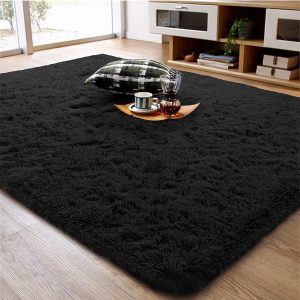The Best Rugs

Our Review Process
Don't Waste Your Money is focused on helping you make the best purchasing decision. Our team of experts spends hundreds of hours analyzing, testing, and researching products so you don't have to. Learn more.
Our Picks For The Top Rugs
Feel cozy in your space with this velvety rug. It has a 1.57-inch pile and a high-density shag. The rug has gripping dots on the underside to prevent slipping and sliding.
Velvety FeelThis rug is plush and soft and creates a cozy ambiance.
This rug has a high-density sponge layer that makes it incredibly soft. It features a non-slip backing for safety. The rug is versatile and can be used in any room.
Like a CloudThis rug feels shaggy and fuzzy.
Enjoy the soft and shaggy texture of this rug. It features a 1.5-inch high pile of faux fur. The rug can be hand washed or wiped clean.
Lovely TextureThis rug has a 1.5-inch high pile that is soft and velvety.
You can vacuum or machine wash the rug to ensure it stays fresh and clean. The rug is thick, plush and shaggy. It has a non-slip bottom to prevent sliding.
Easy to CleanThis rug is easy to keep clean.
Buying Guide
One of the easiest ways to bring a room together and create visual interest is with a beautiful rug. They can be used to keep your feet warm during the cooler months and also help you bring out a pop of color in a monochrome space. Whether you want something functional or stylistic, you can achieve it with a rug.
The first thing to determine when you’re thinking of buying a rug is the goal you want to achieve. For example, are you looking for a statement piece that is going to create intrigue among your guests, or do you want a secure rug that helps to minimize slips in high-traffic hallways? Do you want something soft for your little ones to play on, or do you want a vintage element to capture the eye?
Size and shape go hand in hand. Rugs are most commonly square, rectangular or circular. Within those shapes, you can look at different sizes based on the space you have available. Keep in mind that going too small or too large will affect everything else in the room, so it’s best to look at size very carefully and align it with the goal you have in mind. For example, if you want to have a statement piece in the dining room, you will want to get a rug that is about two feet wider than your dining table on all sides. If you want to reduce slipping in the kitchen, opt for a rug that is long and narrow and covers all the high-traffic spots like in front of the sink and stove.
Rugs come in a number of different materials. Natural fibers like wool, cotton and silk are long-lasting and durable, and great for hiding dirt. They can be on the pricey end, though, and many will require professional cleaning. Another option is a rug made from synthetic fibers such as acrylic or polyester. This material is easy to clean and stain-resistant. While synthetic fiber rugs are more affordable than nature fiber ones, they are less durable and may need to be replaced sooner. Another option for material is artificial silk, which is affordable and available in many different patterns and colors. However, this material is absorbent, which is a bad quality in a rug because it attracts moisture.
What to Look For
- When you’re considering how big of a rug you want to get, it’s best to grab some painter’s tape and mark the size of the rug on the floor with the tape. This will give you an exact visual representation for where your rug will be, so you can determine if it’s too big or too small.
- Carefully determine what kind of pile you need on your rug, which refers to the density or thickness. Low-pile rugs are ideal for high-traffic areas such as hallways or kitchens because they have short fibers and loops that are easy to clean. High-pile rugs have tall fibers and loops, so they are best for spaces like bedrooms or living rooms. Keep in mind that a higher pile will provide more insulation and sound buffering than a lower pile.
- If you want to increase the durability of your rug, opt for getting a rug pad to place underneath it. With a rug pad, you can minimize the rug bunching up, creasing and slipping. It also provides a layer of cushion so heavy furniture doesn’t damage the fibers of the rug. Look for a rug pad that has solid grip for high traffic or slippery areas such as bathrooms and kitchen.
More to Explore
Rugs have a rich and fascinating history. Ancient tribes made rugs by weaving together reeds and grasses, and these were used to keep the ground warm during cold months. Some nomadic tribes used camel, goat and sheep hair to weave rugs as well. In ancient Egyptian tombs, archeologists have found evidence of rugs that are more than 4,000 years old. Rugs shifted from being practical items to showing prestige and social status as civilizations advanced. Persians created intricate rugs by weaving gold and silver into the fibers. Some rugs even had precious stones weaved into them.
















